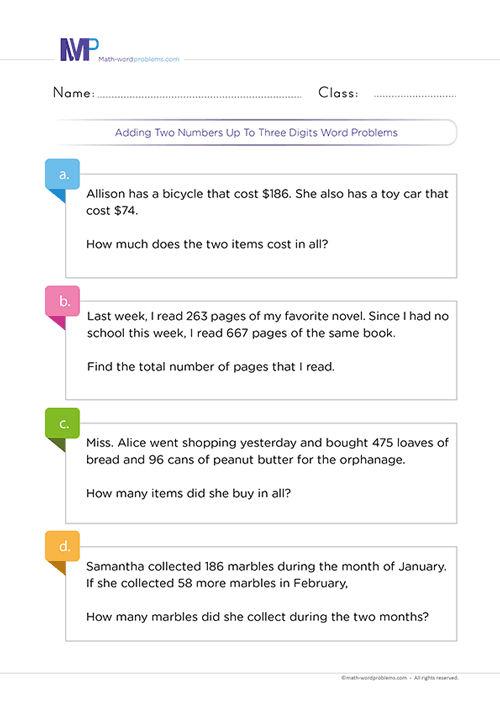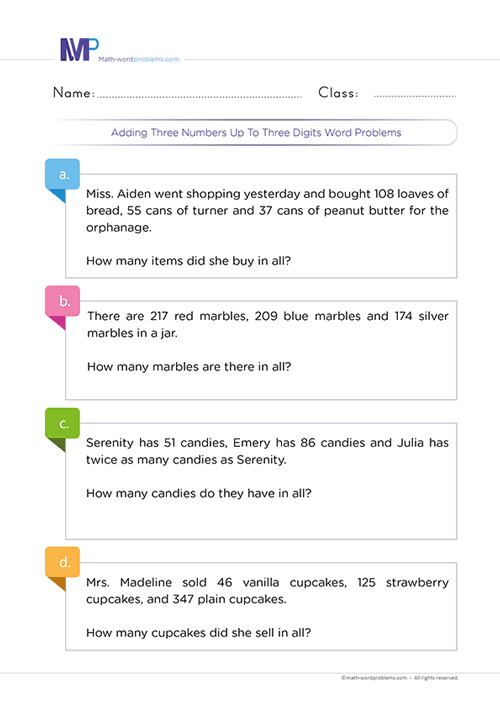 Strategy to add three numbers up to four digits word problems
Strategy to add three numbers up to four digits word problems

- INTRODUCTION
- Step 1 IDENTIFY
- Step 2 STRATEGIZE
- Step 3 SET UP
- Step 4 PROVIDE A SOLUTION
- Step 5 CHECK YOUR WORK
Get more contents on this skill...
This unique strategy to add three numbers up to four digits word problems will provide a solid framework for 3rd Graders to develop a conceptual understanding of all addition problems.
We will provide tips on modeling and identifying the problem types of larger digit addition word problems. With all this, kids can visually represent the addition of three numbers up to four digits word problems accurately.
Also, this strategy to add three numbers up to four digits word problems consists of practical instructional components that will improve and upgrade your kids' ability to solve simple and complex addition word problems efficiently.
Steps on how to add three numbers up to four digits word problems
The following steps on how to add three numbers up to four digits word problems will provide your kids with the basic strategies they need to understand and efficiently add three numbers up to four digits word problems.
So, to prepare kids for success in problem-solving, our outstanding guide will focus on critical concepts and procedures on the unique strategy to add three numbers up to four digits word problems.
Furthermore, our design emphasizes the importance of mathematical practices to develop kids' conceptual understanding of adding three numbers up to four digits problems. Therefore, the thrilling real-life examples below will be a practicing medium and show you how magical these steps work.
Step 1 IDENTIFY THE PROBLEM
To identify the problem,
- First, you must read the problem between the lines to understand it,
- Then, identify and underline relational statements,
- Now, reread the problem and try to sort out important numbers and keywords in the problem;
As for keywords, here are some common keywords that you will see when you come across addition word problems, namely:- add, plus, more, total, increase, together/all together, combined, sum, grow, join, both, in all, altogether, how many in all, how much, and, etc.
Note: learners should understand that it would be best not to rely entirely on keywords alone because a particular keyword can have different meanings in different word problems.
In that case, you need to read the question very well to understand the situation the word problem describes. After reading, you will also find out if the problem makes sense first before determining which operation you need to use.
Step 2 STRATEGIZE AND DETERMINE THE OPERATIONS
Now, ask yourself, “How will I solve this problem?”
Here you are expected to apply the read-to-understand rule. In this step, you have to read the word problem and try to interpret it in your own words.
Furthermore, since each word problem may require a different way to solve it, the key points below will enable young math learners to tackle any word problem irrespective of the way the problem is.
- First, the keyword(s) in the word problem will help clarify the operation you need to carry out.
- However, as mentioned above, relying on keywords alone to solve word problems has some limits.
- So, that said, you must first read the word problem to understand the situation that the problem is describing,
- Reading the problem to understand it will enable you to identify the problem type and relational statement, which, together with the keyword(s) in the problem, will determine the accurate math operation that you need to use;
Step 3 SET UP A NUMBER SENTENCE AND AN EQUATION
- Now, after knowing which operation you will perform from step 2 above, form short phrases to represent the given word problem,
- These short phrases or sentences represent the vital information that makes it easier to solve the word problem. In order words, it is like a diagram of the word problem,
- Then, you can deduce a solvable maths equation to represent the information given in the phrases you constructed above;
Step 4 SOLVE THE PROBLEM
Next, after writing down the maths equation, you can solve the problem using any addition method of your choice, preferably the column method. Furthermore, always include the unit of measurement in the final result
Step 5 VERIFY YOUR ANSWER
Finally, check your work to make sure that your answer is correct. For instance, since you are dealing with only numbers and not algebraic expressions, it is good to use reasonableness by estimation to see if your answer makes sense.
Therefore, if you estimate and the answer is close to what you have, your answer is correct. However, if your answer is beyond reasonable limits, you must go back to step one and start again.
Examples of how to add three numbers up to four digits word problems
Example One
Step 1:First, read the problem and underline all the relational statements. After doing this, you will find that the important numbers in the problem are 943, 1, 300, and 528. Also, the keyword in the word problem is “how many.”
Step 2:Next, ask yourself, “How can I tackle this problem?”
First, interpret the problem in your own words.
The problem describes a census carried out in a small country. And during this, Peter records a certain number of men, women, and children, respectively.
Now, the problem wants you to find the number of men, women, and children that Peter did record combined.
So, right now, you should ask yourself: “what kind of operation can I use to combine three numbers?”
You see that, from the situation that the problem is describing, from interpreting the problem in your own words, and also from the keyword found in the word problem, it calls for an addition operation.
Step 3:Construct short phrases to represent the most vital information in the word problem.
Also, go ahead and write down a solvable maths equation to represent the information given in the sentence that is in bold below.
- Number of men recorded = 943,
- Number of women recorded = 1,300
- Number of children recorded = 582
- Therefore, the number of people Peter recorded = the number of men recorded + the number of women recorded + the number of children recorded.
→943 + 1, 300 + 528 = ?
Step 4: From step 3 above, stack the values in the equation you formed, so their place values line up. Then, add the values using any method, preferably column addition. Also, always add the unit of measurement to the final result.
So, Peter recorded a total of 2,771 people.
Step 5: Finally, check your work to ensure your answer is correct. Since you are dealing with only numbers and not algebraic expressions, it is good to use reasonableness by estimation to see if your answer makes sense.
So, if you estimate and the answer is close to the one you have, then your answer is correct. However, if your answer is beyond reasonable limits, you must go back to step one and start again.
Example one: solution c
Step 1: Start by reading the problem and underlining all the relational statements. After doing this, you will find that the important numbers in the problem are 5,854, 9,201, and 521. Also, the keyword in the word problem is “how many.”
Step 2:Next, ask yourself, “How can I solve this problem?”
Now, try to interpret the problem in your own words.
The problem is that a private university has a certain number of boys, girls, and professors..
Now the problem wants you to find the number of people in the private university as one body.
Now the question is: “which operation can I use to put the numbers of three sets of people as one?”
You see that, from the situation that the problem is describing, from interpreting the problem in your own words, and from the keyword found in the word problem, it calls for you to do an addition operation.
Step 3:After that, you can form short phrases representing the most vital information in the word problem.
Furthermore, write down a solvable maths equation to represent the information given in the sentence that is in bold below.
- Number of boys in the university = 5,854,
- Number of girls in the university = 9,201,
- Number of professors in the university = 521
- Therefore, the number of people in the university = the number of boys + the number of girls + the number of professors;
→ 5,854 + 9,201 + 521 = ?
Step 4: Then, from step 3 above, stack the values in the equation you formed, so their place values line up. Then, add the values using any method, preferably column addition. Also, always include the unit of measurement in the final result.
So, there are 15,576 people in that university
Step 5: Finally, check your work to ensure your answer is correct. Since you are dealing with only numbers and not algebraic expressions, it is good to use reasonableness by estimation to see if your answer makes sense.
So, if you estimate and the answer is close to the one you have, then your answer is correct. However, if your answer is beyond reasonable limits, you must go back to step one and start again.





